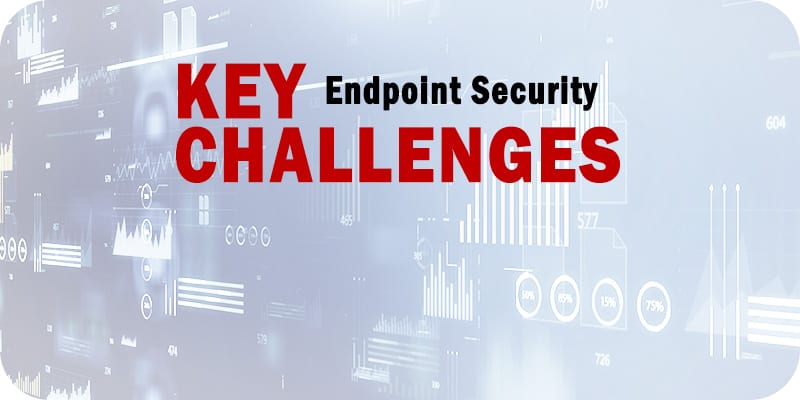What are Five Key Challenges in Endpoint Security for 2021?


What are five key challenges in endpoint security for 2021?
It’s officially Q2 of 2021, and already we find ourselves in the midst of one of the worst cybersecurity years on record. Breach upon breach upon breach, resulting in millions of users’ data already exposed and dozens of reputations tarnished.
So making endpoint security, which prevents the exploitation of devices and other network gateways by threat actors, a priority proves essential. However, before you can select an endpoint security solution, you need to under the five key challenges in endpoint security most common in 2021. Without this understanding, you might just select a solution for selecting a solution, leading to overcomplicated and overburdened security networks.
Five Key Challenges in Endpoint Security for 2021
1. Data Loss
Migrating to the cloud and otherwise undergoing a digital transformation offers plenty of benefits for enterprises of all sizes. The cloud provides new means of communication, collaboration, creation, and synthesis all of which contribute to the bottom line.
However, scaling the IT environment like that causes several challenges in endpoint security. Specifically, you can easily lose track of all of the data following through the network. For example, your users could create a brand new database in a public cloud to help them finish a project…and then just leave it up for discovery and exposure by hackers down the line. Alternatively, emails flow in and out of your environment every day. Do you know what’s actually leaving the network at any given moment?
You need to if you want to keep your sensitive data secure. This is where data loss prevention (DLP) enters the conversation. It prevents critical data from leaving the network without permission and prevents users from uploading data or creating databases without authorization. You can keep a better eye on all of your data through your network, regardless of size.
2. Remote Workers
Keeping an eye on your data can prove a hassle. Keeping an eye on all your workers even as they operate across multiple Wi-Fi connections and multiple devices while dealing with the fallout of a global pandemic? Rather more than a mere challenge for most businesses.
Remote work dovetails with several of the other challenges in this list, which we’ll discuss later on in the article. Certainly, a lack of oversight can cause data loss with remote workforces. Yet in this case, we can address some of the issues raised by your remote workforce and their Wi-Fi connections.
Public and personal Wi-Fi connections create plenty of openings for hackers to intercept traffic or impersonate users. They simply lack the security of a corporate Wi-Fi connection. To handle these key challenges in endpoint security for 2021, modern solutions should offer virtual private networks (VPNs) either as capabilities or through partnerships. VPNs extend corporate connection protections to personal Wi-Fi, ensuring employees can work from anywhere safely.
3. Mobile Devices/BYOD
Legacy endpoint security can’t process mobile devices, especially not those introduced en masse through bring-your-own-devices (BYOD) policies. Mobile devices provide flexibility and comfort, but those very factors make them harder to secure and more difficult to monitor.
Solving key challenges in endpoint security stemming from mobile devices requires embracing mobile security as a necessary component (and in some cases distinct solution from) next-generation endpoint security. Before selecting a solution, evaluate how many devices connect to your network on a daily basis. Then, see if the solution in question matches those demands and can scale if those mobile devices increase over time.
4. Applications
Yes, applications can prove a challenge in and of themselves. Just remember the problems that arose last year (and some continue to struggle with) with Zoom as video conferencing apps became essential to remote workflows.
But that’s just the tip of the iceberg. Think of all the remote work tools, financial and tax software, and other security tools currently operating on your network. Do you know how they might be absorbing or otherwise processing your data? How do they communicate with their creators and owners? In fact, are you certain you know how those companies (legitimate and otherwise) store and utilize the data they interact with?
Your business needs application control to secure these applications and prevent them from acting against your best interests. This capability restricts apps as they move through the network and act unilaterally, ensuring they can’t act beyond what you permit them to do.
5. Overall Visibility
A recurring theme becomes obvious throughout this article; visibility matters in endpoint security and in solving challenges facing it. Without visibility, how can you know where the threats are, or how they might be operating in your network?
This is the role of endpoint detection and response (EDR). It finds threats that penetrated the digital perimeter and alerts your IT security team for faster investigation.
Learn more in the Endpoint Security Buyer’s Guide.



















